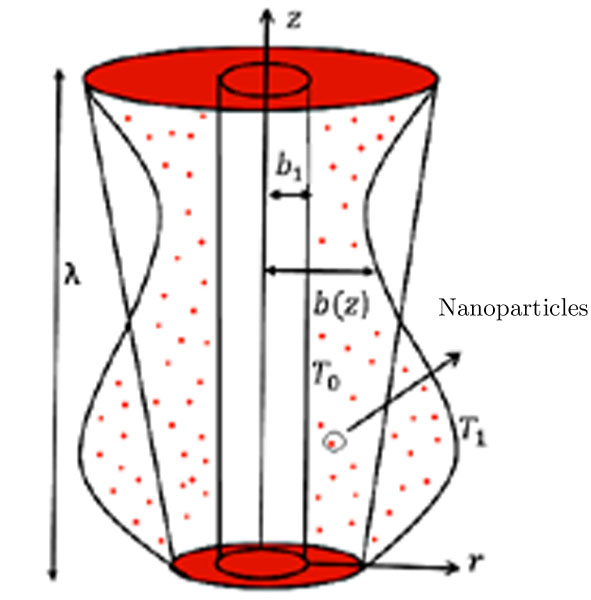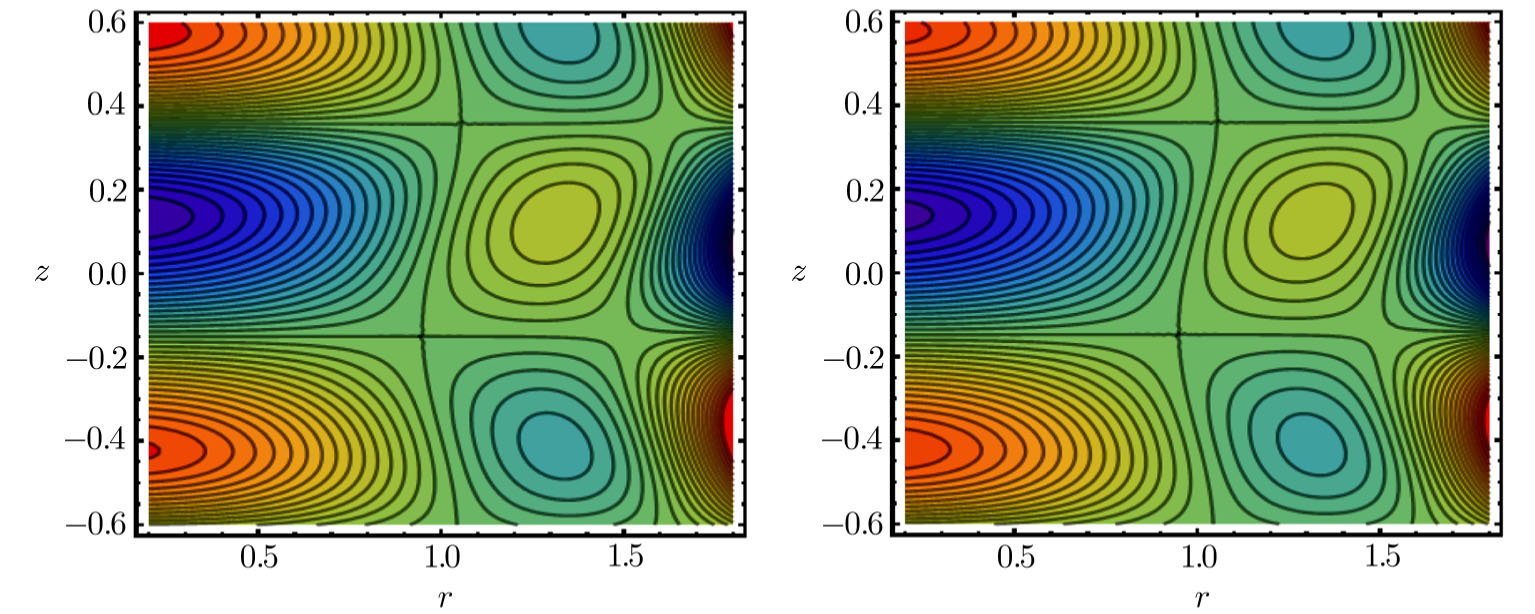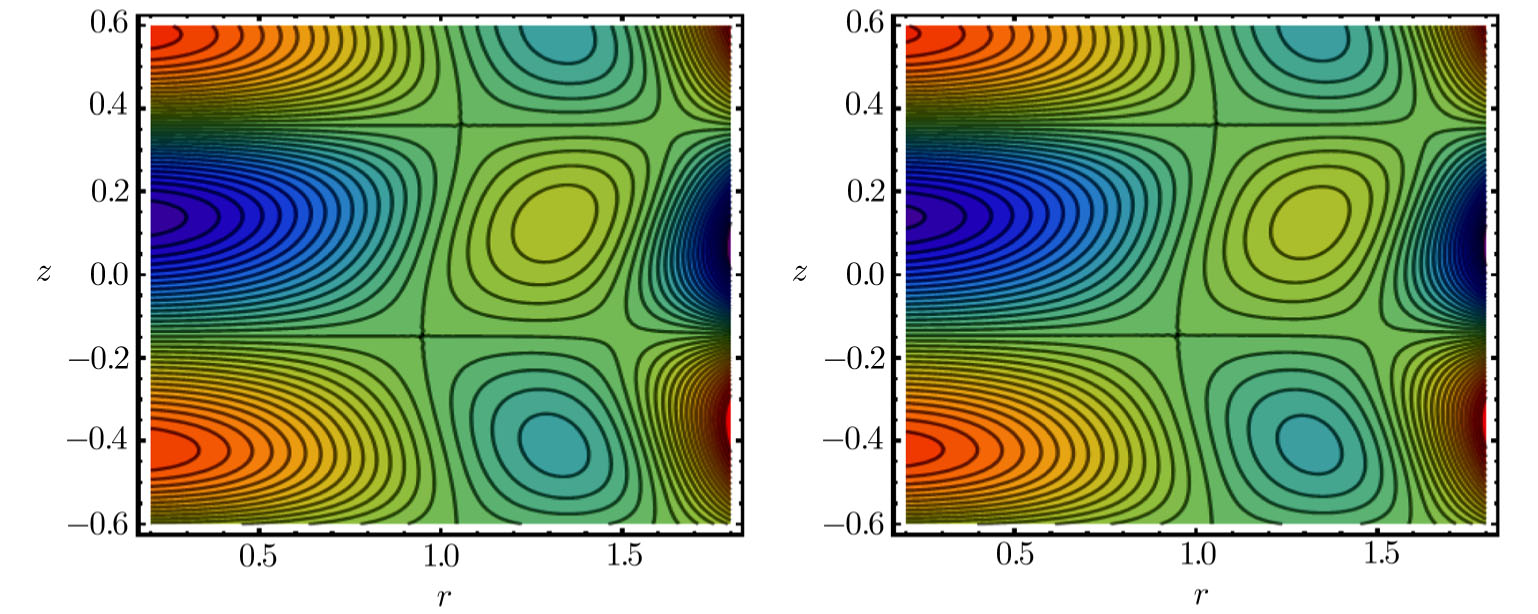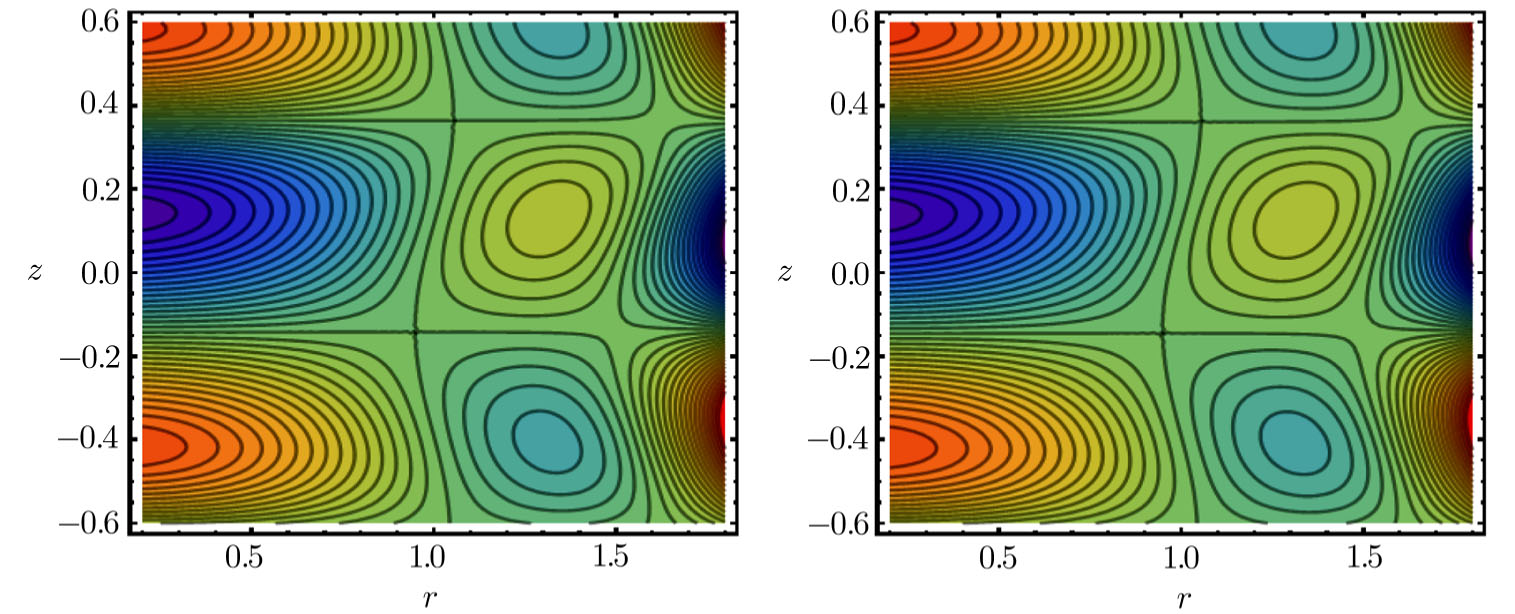† Corresponding author. E-mail:
Supported by the project from HEC (SRGP) (No:21-1712/SRGP/R&D/HEC/2017)
The present article is a study of mixed convective peristaltic flow of Cu-blood nanofluid confined in a non-uniform tube along with the velocity slip conditions and wall properties. Endoscopic or catheterized special effects are also taken into description. Upon utilization of the large wavelength and small reynolds number approximation, the non-dimensional governing differential equation took a more simplified form, which is then solved for the exact solutions. Afterwards, these outcomes are offered graphically and are debated in detail. Velocity profile for pure blood as well as Cu-blood and no-slip and slip effects are also discussed separately. Streamlines pattern is also discussed for different physical parameters.
The term peristalsis is related to the Greek word peristaltikos, which defines compressing and clasping. The peristaltic passage is a device of fluid flow, which takes place due to the circulation of wave trains along the walls of tube/channel. In physical situations the prohibition of pumping machinery makes this mechanism indispensable. In general, its occurrence depends on the pressure difference variations. Pumping of biofluids through this mechanism can be observed in many physiological systems, e.g., lymph movement in lymphatic vessels, fluid mechanics in perivascular space of brain, chyme movement in intestinal tract, urine transport through the ureter, swallowing of food through esophagus and sperm transport in male reproductive tract etc. These peristaltic pumps are also widely used in industry and medicine, for example, to transport aggressive or corrosive fluids and for dialysis etc. From above explanation of the peristaltic transport mechanism, it is clear that the contaminations taking place due to direct contact with the external environment can be avoided by utilization of this mechanism. This advantage was convenient enough to encourage engineers to design various industrial devices using this mechanism like, hose pumps, pumps utilized to transport of corrosive and sensitive fluids in nuclear industry, roller/finger pumps and heart-lung and dialysis machines etc. The relevance about the physiological applications of peristalsis was mainly given by Kill’s[1] research work. After some time, Latham[2] and Shapiro et al.[3] presented earliest peristaltic transport models for fluid motion. After above mentioned pioneering work, many researchers tended to explore the behavior of peristalsis by considering different aspects.[4–10]
Lately, a new branch of fluid mechanics namely “nanofluid dynamics” has emerged into spotlight which has diverse applications in the field of energy, medical science and process systems engineering. Nanofluids are engineered by suspending nanometer-sized particles in the base fluid such as water, propylene-glycol, emulsions, lubricants, coolants, biofluids, oil and silk fibroin to enhance thermal conductivity of the fluid. Although, the great Scottish theoretical physicist, James Clerk Maxwell proposed the concept of nanofluids initially in 19th century, however, the term “nanofluid” was introduced after more than a century by Choi.[11] After, Choi[11] laid first stone in the field of nanofluids many researchers intended to explore this area of research.[12–16]
Recently, the peristaltic flow of nanofluids gained significant attention in biomedical engineering, most particularly in hyperthermia, drug delivery schemes and cryosurgery as a way to annihilate the undesired tissues in cancer therapy. The study of peristaltic flow of nanofluids by adopting Buongiorno model through a channel is carried by Tripathi and Bég[17] under the approximations of long wavelength and low Reynolds number. Zeid[18] studied the combine effects of radiation, viscous dissipation and peristaltic motion of non-Newtonian nanofluid with heat transfer in an asymmetric channel while using the long-wavelength assumption. Sreenadh et al.[19] assumed the small reynolds number and elongated wavelength approximations along with the asymmetric channel to scrutinize the peristaltic transport of nanofluid while taking into account the slip effects. Reddy and Makinde[20] explored the peristaltic flow of Jeffrey nanofluid through an asymmetric channel while considering the combined effects of buoyancy forces, magnetic field, thermophoresis and Brownian motion. Their research revealed that with an upsurge in the power of magnetic field velocity and nanoparticles concentration decrease while the temperature increases. Ghasemi[21] adopted the differential transformation method to determine the highly accurate analytical solution for the peristaltic nanofluid flow in drug delivery systems in the presence of thermophoresis and Brownian motion effects. Sucharitha et al.[22] obtained the exact and numerical solutions for the problem of peristaltic flow of nanofluid confined in a uniform or in a non-uniform porous channel in the presence of Joule heating and wall flexibility. Their key findings revealed that for uniform channel velocity is low as compared to the diverging channel but, opposite effects can be seen for the temperature and concentration fields. The exact solutions for the combined effects of wall properties and variable viscosity on the peristaltic flow of single wall carbon nanotubes are determined by Shahzadi et al.[23]
Some new dynamic features come into view when nano/micro scaled fluidic devices are concerned due to direct contact between the solid surfaces of the fluid container and the fluid constituent. Investigations suggest that for the nano/micro scale fluid flow no-slip condition near walls is not true, however, a certain degree of tangential slip must be considered. Applications regarding no-slip conditions include the polishing of the optical coatings, artificial heart valves and internal cavities, refrigeration equipment, inexpensive lubricating and many industrial processes. After pioneering work done by Navier,[24] Choi et al.[25] and Matthews and Hill[26–27] many researchers are seemed to be paying more attention to this phenomenon.[28–30] Khan et al.[31] discussed numerical study of partial slip on the MHD flow of an oldroyd 8-constant fluid. They concluded the result that the increase of the partial slip parameter, reduced the boundary resistance that leads to the increase of the velocity over the whole cross section. Derek et al.[32] explained experimentally that the fluid shows non-continuum effects such as slip flow when the molecular mean free path length of the fluid is comparable to the distance between the plates as in nano channels or micro channels. Renksizbulut et al.[33] explained the slip-flow and heat transfer in rectangular microchannels with constant wall temperature. They explained that the knudsen number is a measure of the degree of rarefaction, when lies in the range 10−3 < Kn < 10−1, deviations from continuum behavior arise close to the walls where, in a thin layer named the Knudsen layer, molecular collisions with the walls lead over intermolecular collisions. They also explained that for this range of Knudsen numbers (slip-flow regime), the typical Navier-Stokes and energy equations can still be adopted with modifications to the boundary conditions allowing for velocity-slip and temperature-jump at the walls. Zhang[34] discussed fluid-solid interfacial shear strength for some ordinary fluids. In an another paper Zhang,[35] explained review of hydrodynamic lubrication with interfacial slippage and concluded that the limiting shear strength model was more sensible and suggested as an appropriate model for reviewing the interfacial slippage. Hayat et al.[36] studied impact of wall properties and slip on peristaltic motion of nanofluid with MHD and Joule heating. Abbasi et al.[37] discussed slip effects on peristaltic flow of copper-water nanofluid in an inclined channel with mixed convection.
The aforementioned work motivates us to venture the untouched regime of mixed convective peristaltic transport of Cu-blood nanofluid confined in non-uniform tube with slip and wall properties under large wavelength and low Reynolds number approximations. Due to slip effects non-continuum flow occurred at the peristaltic wall, also we are assuming flow motion for peristaltic problem so channel length is considered large. The exact solutions of the governing coupled differential equations will be obtained for nanoparticle temperature, nanoparticle velocity and stream function. These results will be then plotted and discussed at length.
We have assumed the peristaltic flow occurrence for the two-dimensional incompressible viscous fluid in an annulus in the presence of nanoparticles, velocity slip and wall properties effects are also occupied. The equations for mass conservation, momentum and energy equations along with nanoparticles are defined as







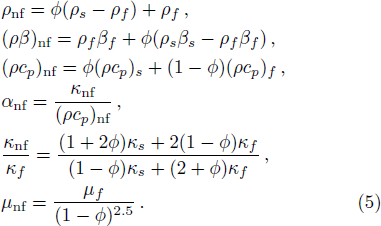
The suitable boundary conditions for flow geometry (see Fig.

The leading equation of motion of the elastic wall may be specified as[22–23]



Introduce the following dimensionless variables
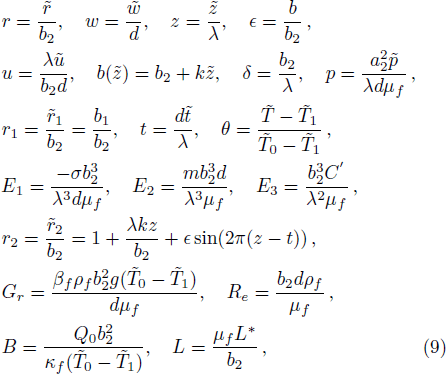




Equation (

The exact solution of the Eqs. (


| Table 1
Thermo-physical properties of fluid and nanoparticles. . |
In order to perceive the assessable effects of numerous parameters convoluted in the study, the velocity, temperature and stream functions are designed for numerous values of the physical parameters.
Tables
| Table 2
Velocity profile for no slip flow for diverse values of ϕ with other fixed values of b2 = 0.24, λ = 0.02, ϵ = 0.05, z = 0.22, r1 = 0.11, Gr = 2.5, E3 = 1.5, t = 0.12, k = 0.16, E2 = 1.3, B = 0.8, E1 = 1.5. . |
| Table 3
Velocity profile for slip flow for diverse values of ϕ with other fixed values of b2 = 0.34, λ = 0.02, ϵ = 0.05, z = 0.22, r1 = 0.11, Gr = 2.5, E3 = 1.5, t = 0.12, k = 0.16, E2 = 1.3, B = 0.8, E1 = 1.5. . |
Tables
 | Fig. 2 (Color online) Nanoparticle temperature profile for diverse values of B and ϕ with other fixed values of b2 = 0.34, λ = 0.22, ϵ = 0.15, z = 0.22, r1 = 0.11, t = 0.12, k = 0.34. |
| Table 4
Velocity profile for no slip flow for diverse values of ϕ with other fixed values of b2 = 0.24, λ = 0.02, ϵ = 0.05, z = 0.22, r1 = 0.11, Gr = 2.5, E3 = 1.5, t = 0.12, k = 0.16, E2 = 1.3. . |
| Table 5
Velocity profile for no slip flow for diverse values of ϕ with other fixed values of b2 = 0.24, λ = 0.02, ϵ = 0.05, z = 0.22, r1 = 0.11, Gr = 2.5, E3 = 1.5, t = 0.12, k = 0.16, E2 = 1.3. . |
Figures
 | Fig. 3 (Color online) Velocity profile (a) for E2 = 1.5, (b) for E1 = 1.5, b2 = 0.34, λ = 0.02, ϵ = 0.05, z = 0.22, r1 = 0.11, t = 0.12, k = 0.16, Gr = 2.5, B = 0.8, E3 = 1.55. |
 | Fig. 4 (Color online) Velocity profile (a) for Gr = 2.5, (b) for E3 = 1.5, b2 = 0.34, λ = 0.02, ϵ = 0.05, z = 0.22, r1 = 0.11, t = 0.12, k = 0.16, E2 = 1.3, B = 0.8, E1 = 1.5. |
Figures
In the present study, we are deliberating the physiological fluid flow analysis for viscous nanofluid due to the combined effects of velocity profile and slip effects. The main deduction can be briefly as follows
(i) Velocity profile drops for swelling values of volume fraction of the nanoparticle for both cases (velocity slip and no slip case).
(ii) Velocity profile increases due to less resistance in the fluid for increasing values of rigidity and stiffness parameter.
(iii) Temperature profile declines with an upsurge in ϕ this justifies that the use of the copper nanoparticle plays a key role for coolant.
(iv) Number of trapped bolus almost remains unchanged for rigidity parameter, stiffness parameter, viscous damping force parameter cases.
| [1] | |
| [2] | |
| [3] | |
| [4] | |
| [5] | |
| [6] | |
| [7] | |
| [8] | |
| [9] | |
| [10] | |
| [11] | |
| [12] | |
| [13] | |
| [14] | |
| [15] | |
| [16] | |
| [17] | |
| [18] | |
| [19] | |
| [20] | |
| [21] | |
| [22] | |
| [23] | |
| [24] | |
| [25] | |
| [26] | |
| [27] | |
| [28] | |
| [29] | |
| [30] | |
| [31] | |
| [32] | |
| [33] | |
| [34] | |
| [35] | |
| [36] | |
| [37] |


